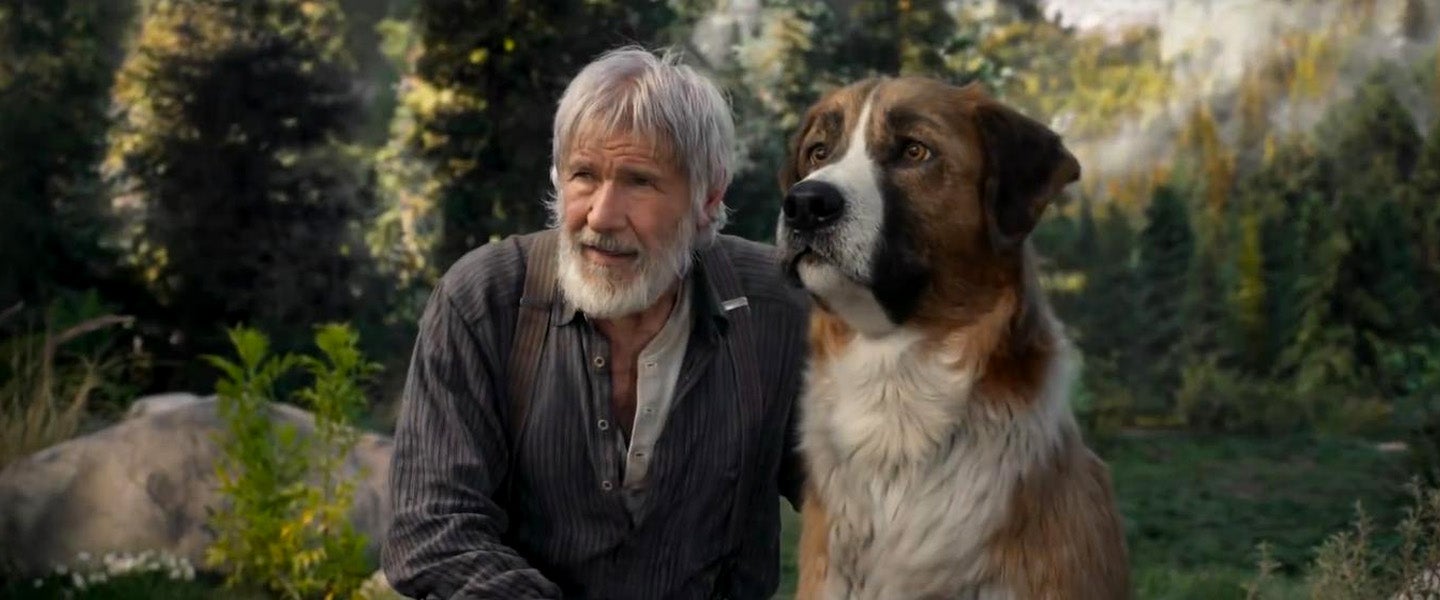Who’s the most famous movie dog of all time? Is it Asta, from The Thin Man? Toto, from The Wizard of Oz? Rin Tin Tin, the star of dozens of films from the 1920s to the 1940s? Old Yeller? It’s got to be Old Yeller, right? (A moment of silence, please, for a very good boy.)
I’ll tell you who won’t make the list: Stuntman Terry Notary, who did the body-movements for Buck, the bewilderingly unconvincing computer-animated pooch who appears opposite Harrison Ford in the latest adaptation of Jack London’s classic novel The Call of the Wild.
That’s right: The dog in a film version of one of the best-known dog stories of all time isn’t actually a dog at all. The Call of the Wild is going the CGI route, despite the long history of canines in cinema — a history so rich that even the Cannes Film Festival’s panel of international critics gives out a “Palm Dog” award every year to celebrate precocious puppers like Nellie in Paterson and Uggie in The Artist.
To be fair, though: Can you really blame The Call of the Wild producers? For every awesome big-screen doggie — like Lassie, or any of the pets in the John Wick pictures — moviegoers have suffered through mutts with no acting chops at all. It’s not entirely the animals’ fault: Maybe they’re starring in the umpteenth straight-to-video sequel of a once-popular film series, working with directors and cast-mates who just want to cash their checks and go home. Or maybe they’re stuck having to do dopey stunts and slapstick gags beneath their dignity.
Sometimes, though, it’s not just the movies that are bad, but also their four-legged stars. Here are a few films that even die-hard dog-lovers will want to avoid… (Note: For the purposes of this list, with rare exceptions, the dogs are referred to by their character names, since often multiple animals are employed to deliver a single motion picture performance.)
Won Ton Ton, the Dog Who Saved Hollywood (1976)
This parodic look back at the Rin Tin Tin phenomenon of the 1920s suffers from a failing common to a lot of 1970s movies and TV shows about Golden Age Hollywood: a deeply rooted skepticism toward the genuine entertainment value and artistry of old movies. More of a broad farce than an homage to the olden days, this film tries to capitalize on its audience’s nostalgic feelings without really honoring their origins, by lining up old stars like Ann Miller and the Ritz brothers for cameo appearances where they don’t get to do much.
But you know what’s especially frustrating about Won Ton Ton? The dang dog doesn’t get to do much either! A lot of this movie is about a canine star’s life after his popularity fades. We see a lot of “Won Ton Ton” looking sad — and even suicidal — in scenes where he’s clearly staring off-stage at his trainer, waiting for the cue to bark forlornly.
Oh! Heavenly Dog (1980)
To be fair to the 1970s, the decade did introduce the first big dog star since Lassie. The scruffy mutt called “Benji” first appeared in a 1974 independent film of the same name, played by a veteran animal actor named Higgins. When Benji grossed 90 times its half-million-dollar budget, a string of sequels ensued; but because Higgins died in 1975, his daughter Benjean took on the role in the movies that followed. Though trained by the same man — Frank Inn — Benjean never had quite the same screen presence as Higgins, lacking her dad’s playfulness and zest.
The worst of the Benjean projects is a bait-and-switch Benji movie. It starts out as a Chevy Chase picture, with the then-popular Saturday Night Live alum playing a murdered detective who gets the opportunity to return to Earth to solve the mystery of his own death. The twist? He comes back as an adorable mongrel. Chase has said that director Joe Camp (the creator of the original Benji) went off-script while shooting many of the Benji scenes, then asked his human star to dub in some dopey dialogue that didn’t do much to make the animal antics any more charming.
Look Who’s Talking Now (1993)
Let’s talk about talking. Quite often — as in Oh! Heavenly Dog — any attempt to evaluate an animal actor’s performance is complicated by the fact that someone has given the critter a voice. Sometimes the dialogue is internal (or at least directed only from beast-to-beast); and sometimes the dog actually speaks aloud to humans. Sometimes the mouths move thanks to CGI, and sometimes thanks to strategically placed sticky foodstuffs. Sometimes the mouths don’t move at all.
Look Who’s Talking Now is one where the mouths don’t move, and where the dogs, Rocks and Daphne — voiced, for some 1993-related reason, by Danny DeVito and Diane Keaton — can hear only each other. But even when they’re not directly communicating, Rocks and Daphne are delivering stream-of-consciousness reactions to everything going on around them, as they witness their masters’ complicated romantic melodrama. The pets have their own storyline too, but for the most part, they mainly appear in repetitive reaction shots, while DeVito and Keaton ramble incessantly on the soundtrack.
Marmaduke (2010)
Can “IP” stand for “infamous pooch” as well as “intellectual property?” Based (very loosely) on a long-running newspaper comic about an oversized, inadvertently troublemaking Great Dane, the Marmaduke movie has Owen Wilson voicing the title character, in a story that sees the big galoot creating problems for his owner in their new Southern California home. The comic was always a single-panel/single-gag affair, but the film links a bunch of “Marmaduke accidentally knocks somebody over” set-pieces into a sappy story about a dog who just wants to make friends — and to make his master proud.
Because Marmaduke is an “animals’ mouths move when they talk” movie — with a few sequences featuring full-on CGI dogs and cats — both the film and the leading performance feel slick and impersonal, and largely disconnected from the source material. It’s also just not that funny. As Roger Ebert put it in his review, “Great Danes can be your best friends, but they are not gifted comedians.”
Underdog (2007)
Like Marmaduke, the movie Underdog tries to squeeze a few nickels out of a character with narrow nostalgic appeal. In this case, the title animal is the superhero who starred in a string of unapologetically Superman-derived 1960s TV cartoons. The film, though, is a live-action version, with a real beagle (helped by a lot of CGI) playing the meek dog who becomes a caped crimefighter after a special chemical cocktail gives him superpowers.
The movie features plenty of nods to the original cartoon — including the mad scientist villain Dr. Simon Bar Sinister, played here by Peter Dinklage — but it just looks wrong to have an actual dog playing Underdog. It doesn’t help either that he’s voiced by Jason Lee, who like Owen Wilson in Marmaduke is so laid-back that he’s practically asleep.
Air Bud: Spikes Back (2003)
The original 1997 Air Bud is a classic of the “there’s nothing in the rules that says a dog can’t ___” genre. The title character is based on a real-life basketball-playing Golden Retriever named Buddy, who also stars in the first film. But by the time the straight-to-video Spikes Back hit the small screen, the real “Air Bud” had died and a bunch of mediocre Buddy imitators had already taken turns playing football, soccer and baseball, before giving volleyball a try.
This last film — which was followed by a string of “Air Buddies” pictures, about the hero’s offspring — is the most tedious, and the most ridiculous. Endless scenes of a dog on a beach bouncing a ball off his snout aren’t especially cinematic. As for the tricky editing (and offscreen paw-wrangling) required to make it look like Bud is delivering a wicked spike? Well, it’s at best unconvincing… and at worst incredibly stupid.
Beethoven’s Treasure Tail (2014)
Like the Air Bud franchise, the Beethoven movies have followed a depressing arc, from the perennial family favorite that is the 1992 original to the dreary grind that is Beethoven’s 2nd, Beethoven’s 3rd and so on. The story of this slobbery, flatulent and oafish (but sorta lovable) St. Bernard was ostensibly rebooted in 2008 with Beethoven’s Big Break, with Jonathan Silverman playing an animal trainer who hits the big time in Hollywood with his big ol’ dog.
It was six years before the Silverman-led series got a direct sequel, and it’s a wacky one too, with a story about Beethoven getting pushed out of showbiz due to his lackluster performances. He ends up befriending a young boy who’s looking for a pirate’s booty in a seaside resort town, and thus, Beethoven becomes pretty much a supporting character in this treasure-hunting adventure. (Then again, it’s never a good sign for a canine actor when the premise of his movie is that he can’t act.)
K-9: P.I. (2002)
Some straight-to-video family movie franchises make sense (hey, Beethoven and Air Bud both made a lot of money!), but were moviegoers really demanding multiple sequels to a middling 1989 Jim Belushi picture? K-9 spawned 1999’s K-911 and then K-9: P.I., with the latter telling the story of what Belushi’s cop character Tom Dooley does after he retires from the force.
Inevitably, he and his German Shepard partner Jerry Lee almost immediately stumble upon a crime they have to investigate. But unlike in the first film, the pair don’t show much chemistry here — perhaps because K-9: P.I. is mostly about the newly idle Dooley’s midlife crisis, and less about his brave and resourceful buddy.
Beverly Hills Chihuahua 3: Viva la Fiesta! (2012)
When referring to some dog movies as “classics,” it’s important to understand that “classic” can be a comparative term. The 2008 action-comedy Beverly Hills Chihuahua isn’t an all-time great when stacked up against, say, Lawrence of Arabia, but it became a blockbuster-level hit for a reason: It’s energetic and relatively clever, with something to say about class privilege and presumption.
It’s also about a thousand times better than its sequels. Beverly Hills Chihuahua 3: Viva la Fiesta! features about a dozen unfortunate doggos, forced to perform a variety of slapstick antics — in tiny sombreros or other “Mexican” paraphernalia — while playing out a story about a papa chihuahua who wants to throw his daughter a quinceañera. This tends to be the life-cycle of a children’s movie franchise: Sooner or later, they all end up being about their middle-aged screenwriters confronting the passage of time and the prospect of an empty nest. Unfortunately, this kind of maudlin, navel-gazing story doesn’t play any better with small dogs as the leads.
The Shaggy D.A. (1976)
One of the Walt Disney Studios’ biggest live-action hits, the 1959 comedy The Shaggy Dog, is a wonderfully weird bit of body-horror (based on a well-regarded novel by Bambi author Felix Salten), about a teenager who begins unpredictably shape-shifting into a sheepdog. In the belated sequel The Shaggy D.A., the boy’s now a man — played by Dean Jones — whose political career suffers when the transformations start happening again.
This is another one of those dog movies where the animal actor is an afterthought. In the most famous clip from this film, a person in a hairy costume — not a dog — punches out one of the bad guys. But hey, this was the best Disney could do in the pre-CGI era. And it just goes to show that from the early days of cinema to now, filmmakers will stop at nothing to achieve one of humanity’s greatest goals: making movies about dogs where the dog actors actually do what they’re supposed to do.

